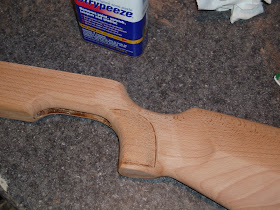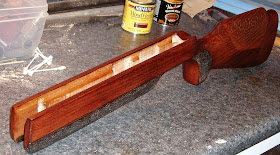On with the show. Where was I on the Haenel anyway? It's been so long that I had to go back through old blogs to see exactly where I'd left off. Oh, yeah, I was about to refinish the Haenel a few weeks ago then took a break to do some "research" that involved mainly looking at old guns. I wanted to add some extra detail to the plain stock, but I wasn't sure what direction to take. Spent some time browsing through old Anschutz brochures from the early 80's as well as viewing lots of online images of vintage target rifles. The style I tried to copy is similar to what Anschutz used on the old 250.

Strypeeze and some masking tape. Exercising caution as I wasn't sure if the old finish on the stippling would bleed into the wood and make a bigger mess to remove.


Didn't notice any color bleeding, so I did the right side--sans tape.

Didn't like the border of the grip stippling curving downward at the top.

Wanted it to run parallel to the top of the forearm, so I sanded it out and penciled in a higher line.

Like so.

Then continued the line on the forearm. A machinist's ruler and a scratch awl.

Doubled the line to match the outline on the grip and used a v-shaped cutter to deepen and define the lines. Also re-cut the border that I'd just sanded off at the grip. This gave a rough approximation of the basic Anchutz 250 stock style.

Wasn't sure I could exactly duplicate the factory stippling on the grip, so most of it was sanded off, too.

Some stippling punches. They work OK, but don't produce as fine a texture as my single punch does. They do allow for relatively fast coverage of large areas.

Stippled the grip on both sides.


Then stippled the forearm.

Tried to get some shadow here to show the stippling details.

Deepened the rear stock mounting hole with a forstner bit. Later, I'll make a screw cup and swap the flat head fastener for a socket head cap screw.

A stiff nylon welding brush makes a good cleaning tool to remove sawdust from the stippling and border lines.

Stained the stippling with Minwax ebony.

Needs another coat as well as some delicate work at the edges.

Two coats later.

This is where it all went wrong. I opted to dye the stock.

Mixed with denatured alcohol. The two test boards I dyed looked good.

Wiped on a thin coat...

Uh, where did the grain go? It just disappeared. The color was nice though.

Sanded out the dye. Had some really choice words about my selection. The dye wasn't the problem, it was just a poor choice for this particular project. I didn't realize how the grain would tone exactly the same as the surrounding wood. Oh well, I'll never claim to be a woodworker. This is all trial and error.

Switched to a stain. Varathane American walnut from the Daisy 717 grip project.

Almost looks like I added some French red.

After it dried, I topped it with a red mahogany stain.

Burnished the stain into the wood with nitrile glove covered hands.

I like the reddish hue. Almost reminds me of the Weihrauch guns.


This is working for me. It has a retro look that should be a good match for the action.

While the stock dried, I pulled the buttplate and polished the sides on the buffer.
More soon. Now I'm on a roll.
Derrick
ReplyDeleteYou must tell me where to get the black nitrile gloves-- they are very Darth Vader. If I had a box of those babies you'd never see my bare hands. (The ones I get from work are purple!)
I may be half blind and several hundred miles away, but from my viewpoint the stain on that stock is nothing short of gorgeous. One would imagine Haenal could have charged much more for this rifle if you were finishing stocks for them.
Kudos to you and Nick for 400 posts. Your machining and gunsmithing skills are one thing. Your ability to stop and take photos and then explain what you did and why with such brevity and wit is another. You guys are brilliant.
Here's to the next 400 posts.
SL,
ReplyDeleteI hand dye each glove using a proprietary mix of carbon black, roofing tar and moxie. Harbor Freight had them in hundred packs for $8.
The stain does look good. My wife even thinks it's OK. It was 100% humidity when I applied it and of course it was still tacky this morning. Brought it inside and set it in front of a fan. It's outside now baking in the sun. I have this bad dream that it won't dry and I'll have to rag it all off with mineral spirits and start over--again.
With all the blog posts, I'm thinking about asking Nick for a raise.
Derrick,
ReplyDeleteWhere do you get the patience and talent for this? The hair on the back of my neck stands up on end when I think of all the work you did on this stock.
And you actually also work for a living??!
-AlanL
Derrick,
ReplyDeleteLooks nice. You found out that the oil stains aren't half bad if you put some work into them. Was the red mahogany stain also a top coat? If not, you really need to finish with something. Minwax Antique Oil Finish (its an oil based varnish) is supposed to give a nice satin sheen and good protection in a couple of coats. I've got a can but haven't tried it, got to build a rifle first:). Then there's always "Tung Oil Finish", Waterlox, , and Minwax wipe-on Poly, not to mention 3000 others:). Two coats of the wipe-on poly in satin will wear like iron and be hardly noticeable.
This comment has been removed by the author.
ReplyDeleteAlanL,
ReplyDeleteWho said I have patience, let alone talent? I stay up until 2AM most nights. It's the only way it all gets done. I don't know how Nick does it with the kids, too.
BG,
I've only used oil based stains. Yeah, I know it still needs a top coat to seal it. Was leaning towards an amber tinted shellac or a few coats of the old stand by, Tru-Oil. I've also got tung oil, several danish oils as well as boiled linseed oil, too. The linseed takes forever to build enough coats--weeks. So, I'd rather not got there. Suggestions?
Derrick,
ReplyDeleteMinwax satin wipe-on poly (oil based) is the easiest. It just wipes on with a rag (its very thin). You can be done in a day if you are in a hurry, as it recoats in two hours. What I would do, though, is put two coats on in one day, with no sanding between, let dry overnight, scratch lightly with #0000 steel wool, wash with mineral spirits, and then put on a very light final coat (or two). Regarding the steel wool b/t coats -- it is not really sanding between coats (unless you have a run or other problem), more like lightly scratching the surface, almost no force. I've also done it with coarse paper towels or scouring pad. You don't want to break through, just put a light haze on the surface. You could add some tint to it, as well, but it is naturally light amber.
The Minwax Antique Oil Finish gets high marks on gunstocks, and I've seen people say that it is better and more durable than Tru-Oil (which is pretty good). You might want to read up on it -- seems to be a good product.
Otherwise, Danish or Tung Oil that you've got (might as well use it) -- I'm assuming they're likely synthetics at least in part; application would be much like for the wipe-on poly above. BLO (unless it is made into a varnish) isn't that good a protectant, and you'll have to wait a week between coats this time of year:).
Derrick,
ReplyDeleteBe careful with your linseed oil. NEVER store a rag dampened or soaked with linseed oil in an enclosed space. It is the number one cause of spontaneous combustion fires. Thought I'd mention it, just in case.
-AlanL
BG,
ReplyDeleteAppreciate the tips. I'm leaning toward the Minwax antique oil finish. I don't recall ever using it before. I may decide to not make yet another hardware store run. Yeah, the BLO makes a complete mockery out of your time. The Royal London Oil (RLO)from Maccari is a good option if you haven't tried it. Order it as needed, don't try to store it as the added dryers tend to evaporate out and the drying times increase substantially.
Wonder if that hold true for the danish oils, too?
AlanL,
I've already threatened Nick with using his pile of Crosman 760's as his funeral pyre. The rags could be used for the ignition.
AlanL
ReplyDeleteSpontaneous combustion? What in the heck are you talking about?
I have it on good authority from Bruce Springsteen that you can't start a fire without a spark.
nice article. i've got a haenel that needs a stock refinishing and this gives me a guide.
ReplyDeleteany particular precautions when removing the action from the stock, or is it pretty much just a drop in?
Drop in, drop out.
ReplyDelete